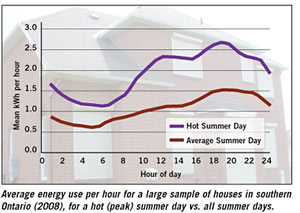By Dr. Guy Newsham
Researchers at the National Research Council’s Institute for Research in Construction (NRC-IRC) are exploring ways to design and operate houses so that their electricity use is minimized during periods when regional demand for power is at its highest. This work is being undertaken with Ontario university collaborators at Waterloo and Carleton.
Demand for electricity across a region is not constant. It can vary greatly by season and time-of-day, yet utilities must be able to meet the demand without any disruption in service. At the highest-use times (“peaks”), utilities often must import additional capacity from neighbouring regions, deploy peak capacity generators, or find ways to reduce demand.
 |
|---|
Analyzing Smart Meter Data
Using smart meter data provided by partner utilities, NRC-IRC researchers are analyzing how homeowners consume electricity during peak periods. They will also use simulations to explore options for house design and operation that could reduce demand during peak-use times, and then apply the most promising techniques to a full-scale test house.
One approach researchers have evaluated is Ontario’s voluntary peaksaver program. In that program, a signal from the utility ensures participating air conditioners don’t run constantly during peak times. The a/c might run for 15 minutes and then be turned off for 15 minutes, even though the house has not yet reached the desired temperature. The temperature in the house will slowly rise, but often this is not a hardship and it greatly helps utilities ensure grid stability.
Other techniques NRC-IRC is looking at include:
•
Turning on the a/c earlier in the day to pre-cool the house before the expected heat wave hits, to see if this can reduce a/c usage later in the day.
•
Using timers on devices such as dishwashers and clothes dryers, so they start automatically during non-peak times.
•
Installing motorized blinds on windows to reduce the need for cooling.
•
Using local generation, such as rooftop photovoltaic (PV) panels to reduce demand from the grid (PV production tends to be highest when summer power demand across the grid is highest).
•
Storing off-peak electricity in batteries for use during peak hours.
While technologies can help to cut energy use, human behaviour is just as important. Evidence suggests that households can voluntarily adjust the times they use some appliances to avoid peak periods, given appropriate incentives and information. The move to time-of-use pricing of electricity is an example of this.
Ideally, a combination of these strategies could result in a “zero-peak” house, one that draws no electricity from the grid during peak times. The zero-peak period might last for only an hour or two and happen only a few days of the year. But those hours could make a big difference for energy suppliers, and ultimately in energy costs for everyone.
NRC researchers plan to demonstrate this concept at a full-scale test house in Ottawa this summer. While it might not be cost-effective for real homes to reduce their peak power use to zero in the near future, the test house will be a proof-of-concept that it is possible. From these studies technologies and strategies that are currently realistic and cost-effective will be identified. The result will be a house that can substantially reduce its peak energy use.
In most other parts of Canada, which don’t experience the same prolonged heat and humidity, the most important peaks are mornings and evenings in winter. The need to address peak use in these regions is not as urgent right now, but many of the same concepts discussed above will work in winter too (think pre-heating instead of pre-cooling, for example).
For more information, visit www.nrc-cnrc.gc.ca/eng/projects/irc/zero-peak.html.
Dr. Guy Newsham is a senior research officer in the Indoor Environment program of the NRC Institute for Research in Construction. He can be reached at 613-993-9607 or guy.newsham@nrc-cnrc.gc.ca


